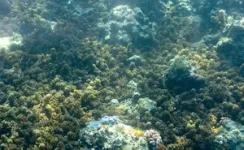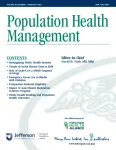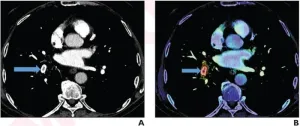(Press-News.org) Memphis, Tenn.—April 5, 2023) Scientists at St. Jude Children’s Research Hospital revealed that human ribosomes decode messenger RNA (mRNA) 10 times slower than bacterial ribosomes, but do so more accurately. The study, published today in Nature, used a combination of field-leading structural biology approaches to better understand how ribosomes work. The scientists pinpointed where the process slows down in humans, which will be useful information for developing new therapeutics for cancer and infections.
Ribosomes are molecular machines within cells, responsible for synthesizing proteins by decoding mRNA. By conducting mechanistic studies on bacterial and human ribosomes, researchers can understand their similarities and differences to develop drugs and understand disease. Many antibiotics, the drugs we use to treat bacterial infections, work by targeting bacterial ribosomes. In humans, changes in how accurately ribosomes decode mRNA have been linked to aging and disease, representing a potential point of therapeutic intervention. This gives the work implications for the treatment of infections and cancer.
“Bacteria have been very well studied for many decades, but the kind of studies that we do, careful mechanistic studies, have been missing on human ribosomes,” said corresponding author Scott Blanchard, Ph.D., St. Jude Department of Structural Biology. “We're very interested in human ribosomes because those are what need to be targeted to find new treatments for cancer and viral infections such as COVID.”
Resolution revolution
Ribosomes decode mRNA using a molecule called aminoacyl-transfer RNA (tRNA) as substrate. The decoding process involves several different steps.
The researchers deployed methods such as single-molecule fluorescence resonance energy transfer (smFRET) and cryo-electron microscopy (cryo-EM) to examine the human ribosome decoding mechanisms. The single-molecule imaging gives the researchers information on how quickly things occur. So, in this case, how quickly human ribosomes go through the different steps during the decoding process. Cryo-EM gives the researchers structural information. So, how the human ribosome looks or what conformations (shapes) it is in at each step. By combining these two methods, the scientists get information on how quickly these processes occur in humans compared to bacteria as well as about the underlying structural causes for any differences they observe.
“We wanted to know how quickly a human ribosome can read the genetic code, how quickly it finds the tRNA that’s complementary to the mRNA,” said co-first author Mikael Holm, Ph.D., St. Jude Department of Structural Biology. “We found that the process is about 10 times slower for human ribosomes than it is in bacteria. But this slow down adds accuracy, because human ribosomes are known to be more accurate at translating the code than bacterial ribosomes.”
Specifically, the researchers found that while humans and bacteria both decode mRNA, the reaction pathway of aminoacyl-tRNA movement during the decoding process is different on human ribosomes and is significantly slower. These differences arise from structural elements in the human ribosome and in the human elongation factor, eEF1A, that together are responsible for faithfully incorporating the right tRNA for each mRNA codon (piece of the sequence). The distinct nature and timing of conformational changes within the ribosome and eEF1A may explain how human ribosomes achieve greater decoding accuracy.
“With our cryo-EM structural studies, we were able to resolve human ribosome structures to atomic resolution, which revealed unprecedented features such as rRNA and protein modifications, ions and solvent molecules present in the human ribosome,” said co-first author Kundhavai Natchiar, Ph.D., St. Jude Department of Structural Biology. “These features finely characterize the molecular basis of interactions of the drug molecules with the human ribosome, which is indispensable for human ribosome–based drug design and discovery.”
Caught in the act
The researchers also pinpointed exactly which step of the decoding process slowed down in human ribosomes. There are two steps in the process of the ribosome selecting the right tRNA: initial selection and proofreading selection. The second step, proofreading selection, is where the ribosome checks for a second time that it chose the right molecule. That is the step that is 10 times slower in humans than in bacteria.
Think of a gymnast, contorting themselves into different shapes on the mat as they work through their routine. This is similar to how ribosomes transition into various conformations to achieve different results. The research showed that a lot of conformational gymnastics that human ribosomes undergo are not present in bacterial ribosomes and are thus likely tied to the slowdown of the proofreading selection process.
The researchers also found that several drugs target the proofreading selection process, not initial selection. So, instead of hitting the step that is similar between humans and bacteria, these drugs focus on the most different, slowest step.
“In structural biology, a single snapshot of a macromolecular machine is not always sufficient to explain how it functions,” said co-first author Emily Rundlet, Ph.D., St. Jude Department of Structural Biology. “Often, the snapshot that’s needed to answer your biological question is not the most stable form of the molecule, but instead it is short-lived and difficult to capture. Using smFRET and cryo-EM together brings the dimension of time to structural biology, which allows us to visualize important transient intermediate steps of human decoding and understand the different mechanisms on a new level.”
Authors and funding
The study’s other authors are Hao-Yuan Wang and Jack Taunton, University of California San Francisco; and Alexander Myasnikov, Zoe Watson and Roger Altman of St. Jude.
The study was supported by the National Institutes of Health (GM079238, GM115327), the Center for Genomic Information Encoded by RNA Nucleotide Modifications (1RM1HG011563), the Swedish Research Council (2017-06313), the National Science Foundation Center for Genetically Encoded Materials (CHE-2002182), UCSF Invent Fund, the Tobacco-Related Disease Research Program (28FT-0014) and ALSAC, the fundraising and awareness organization of St. Jude.
St. Jude Media Relations Contacts
Chelsea Bryant
Desk: (901) 595-0564
Cell: (256) 244-2048
chelsea.bryant@stjude.org
media@stjude.org
Emily Gest
Desk: (901) 595-0260
Cell: (901) 568-9869
emily.gest@stjude.org
media@stjude.org
St. Jude Children's Research Hospital
St. Jude Children's Research Hospital is leading the way the world understands, treats and cures childhood cancer, sickle cell disease and other life-threatening disorders. It is the only National Cancer Institute-designated Comprehensive Cancer Center devoted solely to children. Treatments developed at St. Jude have helped push the overall childhood cancer survival rate from 20% to 80% since the hospital opened 60 years ago. St. Jude freely shares the breakthroughs it makes, and every child saved at St. Jude means doctors and scientists worldwide can use that knowledge to save thousands more children. Families never receive a bill from St. Jude for treatment, travel, housing and food — so families can focus on helping their child live. To learn more, visit stjude.org or follow St. Jude on social media at @stjuderesearch.
END
Humans vs. Bacteria: Differences in ribosome decoding revealed
2023-04-05
ELSE PRESS RELEASES FROM THIS DATE:
Solid-state lithium-sulfur batteries: Neutrons unveil sluggish charge transport
2023-04-05
The scientists designed a special cell in order to observe the transport of lithium-ions between the anode and the cathode in a solid-state Lithium-Sulfur battery. Since lithium can hardly be detected with x-ray methods, HZB physicists Dr. Robert Bradbury and Dr. Ingo Manke examined the sample cell with neutrons, which are extremely sensitive to lithium. In conjunction with Dr. Nikolay Kardjilov, HZB, they used neutron radiography and neutron tomography methods on the CONRAD2 instrument at the Berlin neutron source BER II1. Groups from Giessen (JLU), Braunschweig (TUBS) and Jülich (FZJ) were also involved in the work.
Lithium ...
Stripped to the bone
2023-04-05
Natural disasters can devastate a region, abruptly killing the species that form an ecosystem’s structure. But how this transpires can influence recovery. While fires scorch the landscape to the ground, a heatwave leaves an army of wooden staves in its wake. Storm surges and coral bleaching do something similar underwater.
UC Santa Barbara scientists investigated how these two kinds of disturbances might affect coral reefs. They found that coral struggles more to recover from bleaching than from storms, ...
Emory researchers discover key pathway for COVID organ damage in adults
2023-04-05
Even after three years since the emergence of COVID-19, much remains unknown about how it causes severe disease, including the widespread organ damage beyond just the lungs. Increasingly, scientists are learning that organ dysfunction results from damage to the blood vessels, but why the virus causes this damage is unclear. Now a multidisciplinary team of Emory researchers has discovered what they believe is the key molecular pathway.
Results of their study, published today in Nature Communications, show that COVID-19 damages the cells lining the smallest blood vessels, choking off blood flow. These results could pave the way for new treatments to save lives at a time when hundreds ...
Population Health Management
2023-04-05
The COVID-19 pandemic has underscored the inequality in American health care systems, which consistently neglect the needs of underserved communities, leaving them without access to quality care. A commentary published in Population Health Management highlights the need for a transformational change in our health care systems to advance health equity and address structural racism and health disparities affecting wellbeing. Click here to read the article now.
Coauthors Dr. Jonathan B. Perlin, President ...
Teens who trust online information find it less stressful
2023-04-05
ITHACA, N.Y. -- Teens’ trust in the news they consume on social media – or lack of it – may be key to whether it supports or detracts from their well-being, according to Cornell-led psychology research.
Surveying nearly 170 adolescents and young adults from the U.S. and U.K. early in the pandemic, the researchers found that those more trusting of the COVID-19 information they saw on Facebook, Twitter and TikTok were more likely to feel it was empowering, while those less trusting were more likely to find it stressful.
The findings highlight the need for news literacy programs to help young people discern fact-based, trustworthy sources from misinformation ...
WCS names new President and CEO - Monica P. Medina
2023-04-05
The Wildlife Conservation Society (WCS) announced today that Monica P. Medina, the first diplomat in the U.S. designated to advocate for global biodiversity, has been named WCS President and CEO, effective June 1, 2023. Medina, current Assistant Secretary of State for Oceans, Environment, and Science; and Special Envoy for Biodiversity and Water Resources will serve until April 30, 2023, at the U.S. Department of State.
Medina ushered in a new era of environmental diplomacy as a foreign policy priority at the State Department. She will join WCS to lead its mission to save wildlife and wild places, harnessing the power of its four zoos, an aquarium, and its Global ...
IU researchers receive $8.6M NIH grant renewal to study alcohol use, binge drinking
2023-04-05
INDIANAPOLIS--A multi-disciplinary team of Indiana University researchers is focusing their efforts on a growing public health concern: binge and “high-intensity” drinking—extreme drinking behaviors that are increasingly prevalent among college-age adults.
The researchers, who are part of the Indiana Alcohol Research Center, recently received a five-year, $8.65 million grant renewal from the National Institute on Alcohol Abuse and Alcoholism to support this work.
Established in 1987, the Indiana Alcohol Research Center (IARC) is housed at IU School of Medicine and led by director David Kareken, PhD, a professor of ...
Looking beyond the horizon
2023-04-05
Texas Tech’s Thomas Maccarone has received a grant from the U.S. Air Force Office of Scientific Research to study possible impacts of one layer of the earth’s ionosphere upon radio communications.
Maccarone, a professor in the Department of Physics and Astronomy, said the project will have short- and long-term benefits and implications. The one-year grant is for just more than $500,000.
“We will use a set of dipole radio antennas to study what is called the sporadic E-layer of the ionosphere,” he said. “That is the short-term component the Air Force ...
AI cuts CT turnaround, wait times for positive pulmonary embolus
2023-04-05
Leesburg, VA, April 5, 2023—According to an accepted manuscript published in ARRS’ own American Journal of Roentgenology (AJR), a worklist reprioritization tool with artificial intelligence reduced both report turnaround time and wait time for pulmonary embolus-positive CT pulmonary angiography examinations.
“By assisting radiologists in providing rapid diagnoses, the artificial intelligence (AI) tool could potentially enable earlier interventions for acute pulmonary embolus (PE),” concluded lead researcher Kiran Batra, MD, from the department of radiology at University of Texas Southwestern Medical ...
Gone for good? California’s beetle-killed, carbon-storing pine forests may not come back
2023-04-05
LOS ALAMOS, N.M., April 4, 2023—Ponderosa pine forests in the Sierra Nevada that were wiped out by western pine beetles during the 2012-2015 megadrought won’t recover to pre-drought densities, reducing an important storehouse for atmospheric carbon.
“Forests store huge amounts of atmospheric carbon, so when western pine beetle infestations kill off millions of trees, that carbon dioxide goes back into the atmosphere,“ said Zachary Robbins, a postdoctoral at Los Alamos National Laboratory.
Robbins is corresponding author of a new paper published in the journal Frontiers in Environmental Science about carbon stored in living ponderosa pines in the ...







